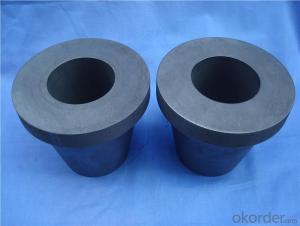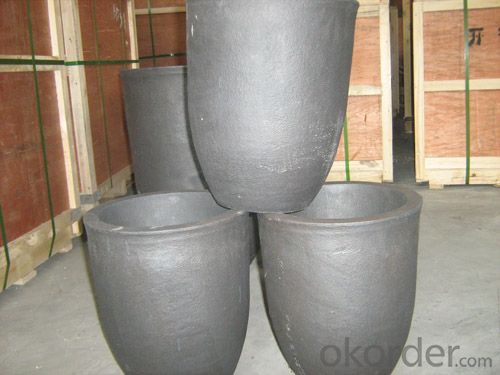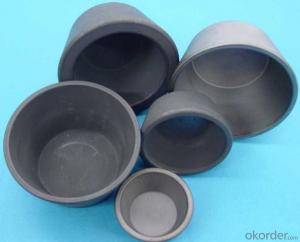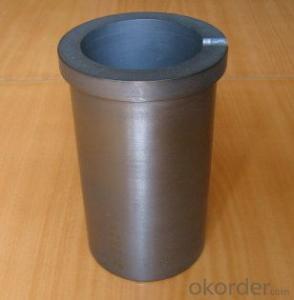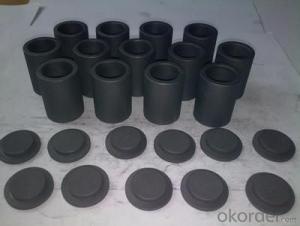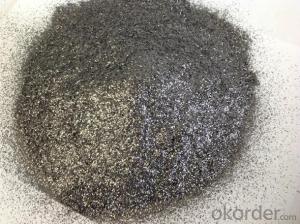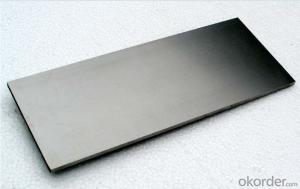Graphite Crucibles/CNBM China High Carbon
- Loading Port:
- China main port
- Payment Terms:
- TT OR LC
- Min Order Qty:
- 0 m.t.
- Supply Capability:
- 100000 m.t./month
OKorder Service Pledge
OKorder Financial Service
You Might Also Like
Feature
1.Long working lifetime: its working lifetime is increased 3-5 times over normal clay-crucible due to the compact body formed under high pressure.
2.High thermal conductivity: highdensity body and low apparent porosity greatly improve its heat conductivity.
3.Newstyle materials: new heat conduction material ensures faster heat conductivity and pollution-free product, reduces adherent slag.
4.Resistance to corrosion:better anti-corrosion than normal clay-crucible.
5.Resistance to oxidation: advanced process dramatically improves its oxidation resistance, which ensures persistent heat conductivity and long working lifetime.
6.High-strength: high-density body and logical structure make the product better compression property.
7.Eco-friendly: energy-efficient and pollution-free, not only ensure metal product purity, but also ensure sustainable development on environment.
8.Multi-function: Can be used in induction graphite crucible furnace
Specification
Bulk Density | g/cc | 1.70-1.88 |
Specific Resistance | μΩ.m | 6.0-15.0 |
Compressive Strength | MPa | 30-80 |
Bending Strength | MPa | 20-45 |
Shore hardness | 30-70 | |
C.T.E.(100-600°C) | x10-6 /°C | 2.5-5.5 |
Ash | % | 0.01-0.2 |
Maximum Grain Size | mm | 0.044-0 |
Picture
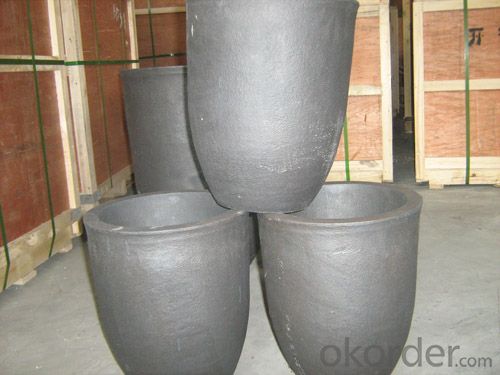
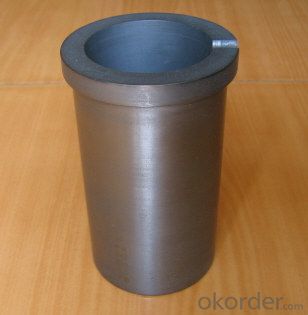
- Q: What is carbon emission and what harm does it do? How can carbon dioxide be prevented?
- Carbon deposition reaction:CH4 = kJ/mol C+H274.92CO = CO2+C +172.4 kJ/mol on.The main cause of carbon analysis is that the ratio of water to carbon is too low, so that the rate of carbon removal is lower than the rate of carbon depositionThe above chemical reactions are reversible reaction, from the analysis of thermodynamics, if the increase in temperature or reducing system pressure, increase the possibility of methane decomposition reaction type is CH4 C+H2 produce coke; possibility of CO reaction 2CO = CO2+C and CO = C + H2 reaction +H2O produce coke decrease. If the temperature is reduced or increased the pressure is on the contrary. The effect of temperature on coke reaction is very large, to avoid the [wiki] [/wiki] carbon catalyst must select the appropriate temperature, avoid carbon deposition area.
- Q: What are the impacts of carbon emissions on coral reefs?
- The impacts of carbon emissions on coral reefs are significant and detrimental. Increased levels of carbon dioxide in the atmosphere lead to ocean acidification, which disrupts the delicate balance of the reef ecosystem. Acidic conditions hinder the ability of corals to build their calcium carbonate skeletons, making them more vulnerable to erosion and bleaching. Additionally, rising temperatures caused by carbon emissions contribute to coral bleaching events, where corals expel their symbiotic algae, leading to their eventual death. Overall, carbon emissions pose a major threat to coral reefs, jeopardizing their biodiversity and ecological functions.
- Q: What are the effects of carbon emissions on agriculture?
- Carbon emissions have numerous detrimental effects on agriculture. Firstly, increased levels of carbon dioxide (CO2) in the atmosphere contribute to global warming, leading to changes in rainfall patterns and more frequent extreme weather events such as droughts, floods, and heatwaves. These weather conditions disrupt agricultural production by reducing crop yields, damaging crops, and increasing the prevalence of pests and diseases. Higher temperatures also accelerate the rate of evaporation, resulting in soil moisture deficits and water scarcity, which negatively impact crop growth and productivity. In addition, elevated CO2 levels can alter the nutritional content of crops, reducing their quality and nutritional value. For example, studies have shown that increased CO2 concentrations can decrease the protein content in wheat and rice, leading to potential health issues for those who rely on these staple crops. Furthermore, carbon emissions contribute to the formation of ground-level ozone, a harmful air pollutant. Ozone damages plant cells, inhibits photosynthesis, and reduces crop yields. It particularly affects sensitive crops such as soybeans, wheat, and cotton. The effects of carbon emissions on agriculture are not limited to crop production. Livestock farming is also impacted as rising temperatures and water scarcity make it more challenging to maintain adequate grazing lands and provide sufficient water and fodder for animals. Additionally, changes in climate patterns can lead to the spread of livestock diseases and pests, further endangering the livestock industry. Overall, carbon emissions have a cascading effect on agriculture, leading to reduced crop yields, lower nutritional value, livestock farming challenges, and increased vulnerability to pests, diseases, and extreme weather events. Addressing and mitigating carbon emissions is crucial to safeguarding global food security and ensuring the sustainability of agricultural systems.
- Q: What are the consequences of increased carbon emissions on coastal regions?
- Coastal regions are significantly impacted by the increase in carbon emissions, with various alarming consequences. One particularly concerning effect is the rise in sea levels, which is caused by the melting of glaciers and polar ice caps due to the warming of the planet. This rise in sea levels poses threats such as increased flooding, erosion, and the loss of coastal ecosystems. Aside from the rise in sea levels, increased carbon emissions also contribute to ocean acidification. When seawater absorbs carbon dioxide, it forms carbonic acid, which lowers the pH of the ocean. This decrease in pH has harmful effects on marine life, especially on coral reefs and shellfish. The acidity of the waters makes it difficult for coral reefs to construct their calcium carbonate structures, leading to bleaching and eventual death. Similarly, shellfish like oysters, clams, and mussels struggle to develop their shells in more acidic waters, impacting their survival and the entire coastal food chain. Moreover, higher levels of carbon emissions contribute to the intensification of storms and extreme weather events. Rising temperatures in coastal regions result in more frequent and severe hurricanes, cyclones, and storm surges. These events cause extensive damage to coastal infrastructure, including homes, businesses, roads, and power lines. The increased frequency of storms also puts coastal communities at a higher risk of displacement and loss of livelihoods. Furthermore, increased carbon emissions contribute to global warming, which leads to higher air temperatures. The warming of coastal regions has adverse effects on the overall ecosystem. For example, warmer waters can cause certain species to migrate or become extinct, disrupting the delicate balance of coastal ecosystems. It can also impact the health and productivity of fisheries, affecting the livelihoods of fishing-dependent communities. To summarize, increased carbon emissions have wide-ranging consequences for coastal regions. Rising sea levels, ocean acidification, intensified storms, and the overall warming of coastal ecosystems pose significant threats to the environment, economies, and communities in these areas. It is crucial to reduce carbon emissions and take proactive measures to mitigate these consequences and protect our coastal regions for future generations.
- Q: What are the consequences of increased carbon emissions on public health systems?
- Public health systems are significantly affected by the increase in carbon emissions. One of the main consequences is the worsening of respiratory diseases like asthma, COPD, and bronchitis. These conditions are aggravated by the presence of fine particulate matter (PM2.5) and ground-level ozone, both of which can deeply penetrate the respiratory system. Furthermore, higher levels of carbon emissions are linked to a higher occurrence of cardiovascular diseases. The release of fine particulate matter and other pollutants from carbon-emitting sources can enter the bloodstream, leading to inflammation, oxidative stress, and the development of atherosclerosis. This can eventually result in heart attacks, strokes, and other cardiovascular complications. Additionally, the spread of infectious diseases is also influenced by climate change, which is driven by carbon emissions. The rise in temperatures and changes in precipitation patterns create favorable conditions for disease-carrying vectors like mosquitoes and ticks. This facilitates the transmission of diseases such as malaria, dengue fever, Lyme disease, and Zika virus. Moreover, extreme weather events and natural disasters associated with climate change can disrupt healthcare infrastructure and limit access to essential services, further impacting public health systems. Moreover, mental health is affected by the increase in carbon emissions as well. The degradation of the environment caused by carbon emissions contributes to feelings of anxiety, stress, and depression, often referred to as eco-anxiety or climate grief. The loss of biodiversity, destruction of natural habitats, and the general uncertainty about the future can have harmful effects on individuals and communities, requiring additional resources and support from public health systems. In conclusion, the consequences of increased carbon emissions extend far beyond the environment and have a profound impact on public health systems. They contribute to the prevalence of respiratory and cardiovascular diseases, facilitate the spread of infectious diseases, and affect mental health. It is crucial to address carbon emissions and adopt sustainable practices to mitigate these consequences and protect the well-being of individuals and communities.
- Q: How does carbon affect the formation of tsunamis?
- Carbon does not directly affect the formation of tsunamis. Tsunamis are typically caused by underwater earthquakes, volcanic eruptions, or landslides, which are not influenced by carbon. However, carbon emissions and climate change can indirectly impact the frequency and intensity of natural disasters, including some potential triggers for tsunamis, such as volcanic activity or landslides near coastlines.
- Q: What is carbon dating and how does it work?
- Carbon dating is a scientific method used to determine the age of organic materials, such as wood, cloth, and bone, by measuring the amount of carbon-14 (C-14) present in the sample. It is based on the principle that all living organisms contain a small amount of radioactive carbon-14, which is formed in the upper atmosphere when cosmic rays collide with nitrogen atoms. This radioactive isotope of carbon is unstable and decays over time, transforming into nitrogen-14. The process of carbon dating begins with collecting a sample from the object of interest. This sample is typically organic matter that was once part of a living organism. The sample is then treated to remove any contaminants and prepared for analysis. In order to determine the age of the sample, scientists measure the ratio of C-14 to stable carbon-12 (C-12) in the sample. This is done using an accelerator mass spectrometer (AMS), a highly sensitive instrument that can detect and measure extremely low levels of C-14. By comparing the C-14 to C-12 ratio in the sample to the known ratio in the atmosphere at the time the organism died, scientists can calculate how long it has been since the death of the organism. The half-life of C-14, which is the time it takes for half of the radioactive isotope to decay, is approximately 5,730 years. This means that after 5,730 years, half of the C-14 in a sample will have decayed into nitrogen-14. By measuring the amount of C-14 remaining in a sample and knowing its half-life, scientists can estimate the age of the sample. Carbon dating is a valuable tool for archaeologists, paleontologists, and geologists as it allows them to accurately determine the age of ancient artifacts, fossils, and geological formations. However, it is important to note that carbon dating is only effective for dating materials up to about 50,000 years old, as beyond this point the amount of C-14 remaining becomes too small to accurately measure.
- Q: What are the impacts of carbon emissions on the stability of grasslands?
- Carbon emissions can have significant impacts on the stability of grasslands. Increased levels of carbon in the atmosphere contribute to global warming, which in turn leads to changes in precipitation patterns and higher temperatures. These changes can result in drought conditions and increased frequency and intensity of wildfires, both of which can destabilize grasslands. Additionally, elevated carbon dioxide levels can promote the growth of invasive plant species, which can outcompete native grasses and disrupt the balance of grassland ecosystems. Overall, carbon emissions pose a threat to the stability and biodiversity of grasslands.
- Q: How does carbon impact the melting of polar ice caps?
- Carbon impacts the melting of polar ice caps primarily through the process of global warming. When carbon dioxide (CO2) and other greenhouse gases are released into the atmosphere, they trap heat and cause the Earth's temperature to rise. This increase in temperature leads to the melting of polar ice caps, as the excess heat causes the ice to melt at a faster rate than it can replenish. Additionally, carbon emissions contribute to the acidification of the oceans, which further accelerates the melting of ice.
- Q: What is carbon black rubber?
- Carbon black rubber is a type of rubber that is reinforced with carbon black particles. Carbon black is a fine black powder made from the incomplete combustion of hydrocarbons. It is added to rubber formulations to enhance its strength, durability, and resistance to wear and tear. This type of rubber is commonly used in the manufacturing of tires, conveyor belts, seals, gaskets, and various other rubber products.
Send your message to us
Graphite Crucibles/CNBM China High Carbon
- Loading Port:
- China main port
- Payment Terms:
- TT OR LC
- Min Order Qty:
- 0 m.t.
- Supply Capability:
- 100000 m.t./month
OKorder Service Pledge
OKorder Financial Service
Similar products
Hot products
Hot Searches
Related keywords

